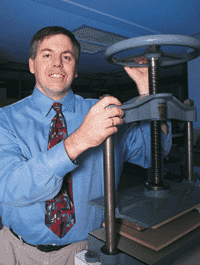
-
Please note that the archive starting 1/2019 is accessible to subscribers only. To gain access, click on link above and then using the email you subscribed under register a password towards the right hand side of the page.
ABOUT BOOK_ARTS-L
- Subscribers, to post a message send to: book_arts-l@listserv.cc.emory.edu
- Full FAQ
with detailed instructions
- Put ALL commands in body of message and send to: listserv@listserv.cc.emory.edu
- To Subscribe send:
subscribe Book_Arts-L "Your full real name"
Leave out the "" . All subscription requests must include the full real name or they will not be approved by the moderator.
- For daily digest: set Book_Arts-L mail digest
- To unsubscribe: unsubscribe Book_Arts-L
OTHER RESOURCES
 The
Multi-lingual Bookbinding/Conservation Dictionary Project: The goal
of this project is to combine, in one place, all the known bookbinding
and book conservation terminology, in as many languages as possible.
The
Multi-lingual Bookbinding/Conservation Dictionary Project: The goal
of this project is to combine, in one place, all the known bookbinding
and book conservation terminology, in as many languages as possible.
- Other Book_Arts-L Projects:
- Liberated Books: New uses for discarded books...
Preserving Special Collections
By LISA DEL COLLE
From the "Staff Circle, Syracuse University Alumni Magazine, Spring 2000.
schmitt shoots!!
As preservation and access librarian, Peter Verheyen G'97 repairs rare books for the Department of Special Collections. He is also the department's web master. |
On the sixth floor of Bird Library, Peter Verheyen G’97 patiently stands over a tray of water with pages soaking in it. At just the right moment he carefully lifts the paper from the water. It’s a process Verheyen has repeated innumerable times as part of his job as preservation and access librarian for the Department of Special Collections in the Syracuse University Library. “When the paper is in relatively good condition this can be routine,” says Verheyen, whose primary responsibility is the conservation and repair of rare books. “However, if the paper is moldy, brittle, or otherwise seriously deteriorated, it can be like taking a piece of tissue paper, putting it in water, and then trying to remove something glued onto it.”
Another common problem Verheyen encounters with books is redrot, which occurs when the leather used in bindings breaks down. Because of inferior tanning and environmental factors, the leather be|omes powdery and eventually disintegrates. To remedy this, Verheyen often has to reinforce the book spines, match leathers, and patch worn areas. Patience, he says, is a key part of the job.
With that patience comes rewards. Verheyen, who earned a master’s degree in library science from the School of Information Studies, has conserved numerous rare books, but his favorite project to date was restoring the Nuremberg Chronicle, a history of the world published in 1493. Verheyen has worked on two copies of this rare text, including one now displayed on the sixth floor of Bird Library (http://www.philobiblon.com/examples/examples.htm). “It’s the world’s first coffee-table book,” he says. “I love the book because the authors used the same woodcuts for different people, and the illustrated cities all look like medieval German villages.”
Verheyen became SU’s conservation librarian in 1995, after serving as rare books conservator at Cornell University. “I got my start as a work-study student doing book repair while an undergraduate at Johns Hopkins,” he says. “When I showed an interest, they showed me a career.” After graduation, Verheyen traveled to Germany for an apprenticeship in bookbinding and studied book restoration in Switzerland. Now Verheyen likes to offer the same opportunities to SU students. “It’s very rewarding to get someone excited about doing this work,” he says.
Working with such sensitive materials may prompt some people to think Verheyen would be constantly worried about failure, but that’s not the case. “Things can happen, but you can’t let that fear of failure paralyze you,” he says. “You get better by watching others and learning from their, and your own, mistakes.” Success in library conservation, Verheyen believes, requires a great deal of independent thinking. “It becomes a judgment call,” he says. “You have to ask yourself, ‘If I do this, will it work?’”
Initially hired on a grant-funded project to conserve and rehouse parts of the Leopold von Ranke collection (SU’s first library), Verheyen expanded his work beyond book conservation to include other projects involving some of the University’s most notable holdings. While Verheyen would like to plan some long-term projects that spark his interest, he is committed to meeting deadlines for grant-funded projects. “It would be nice to go through the stacks and conserve all the old books,” he says, “but there are several lifetimes’ worth of work, and other projects as well.”
One such project is to help the Department of Special Collections go digital, connecting the traditional works of print literature to the online realm of the new millennium. As the department’s web master, Verheyen is currently working to put more inventories of the department’s holdings online, so the information can be accessed from anywhere in the world. He also had 2,000 covers of early 20th-century dime novels, part of the Street & Smith publications collection, scanned. “They are the soap operas and sitcoms of yesteryear,” he says.
Whether he’s working online or with crumbling bindings, Verheyen remains clear about his goal: Keep the book and its history alive. “It’s important to preserve these materials,” he says. “That’s why I like my job.”




